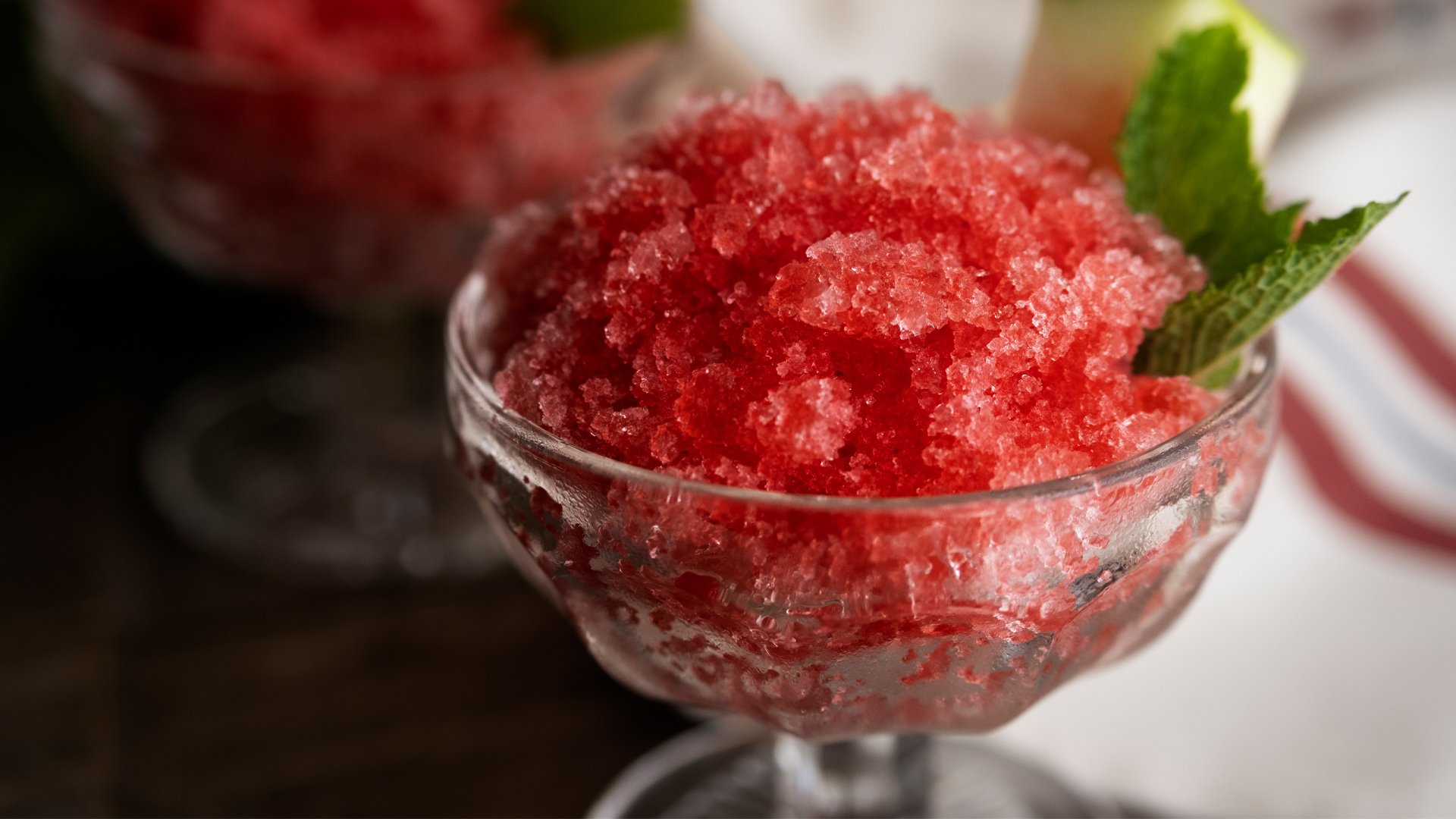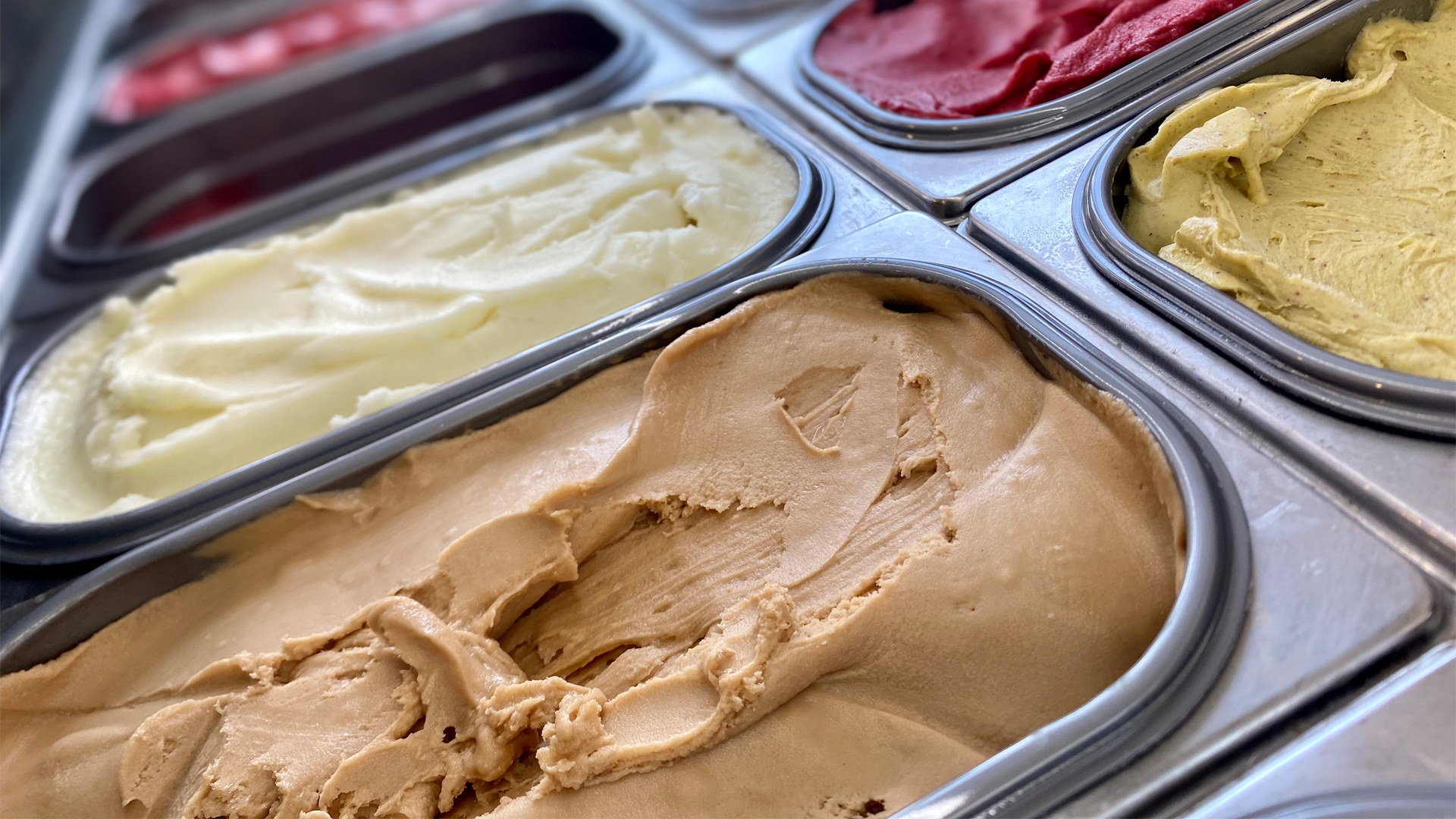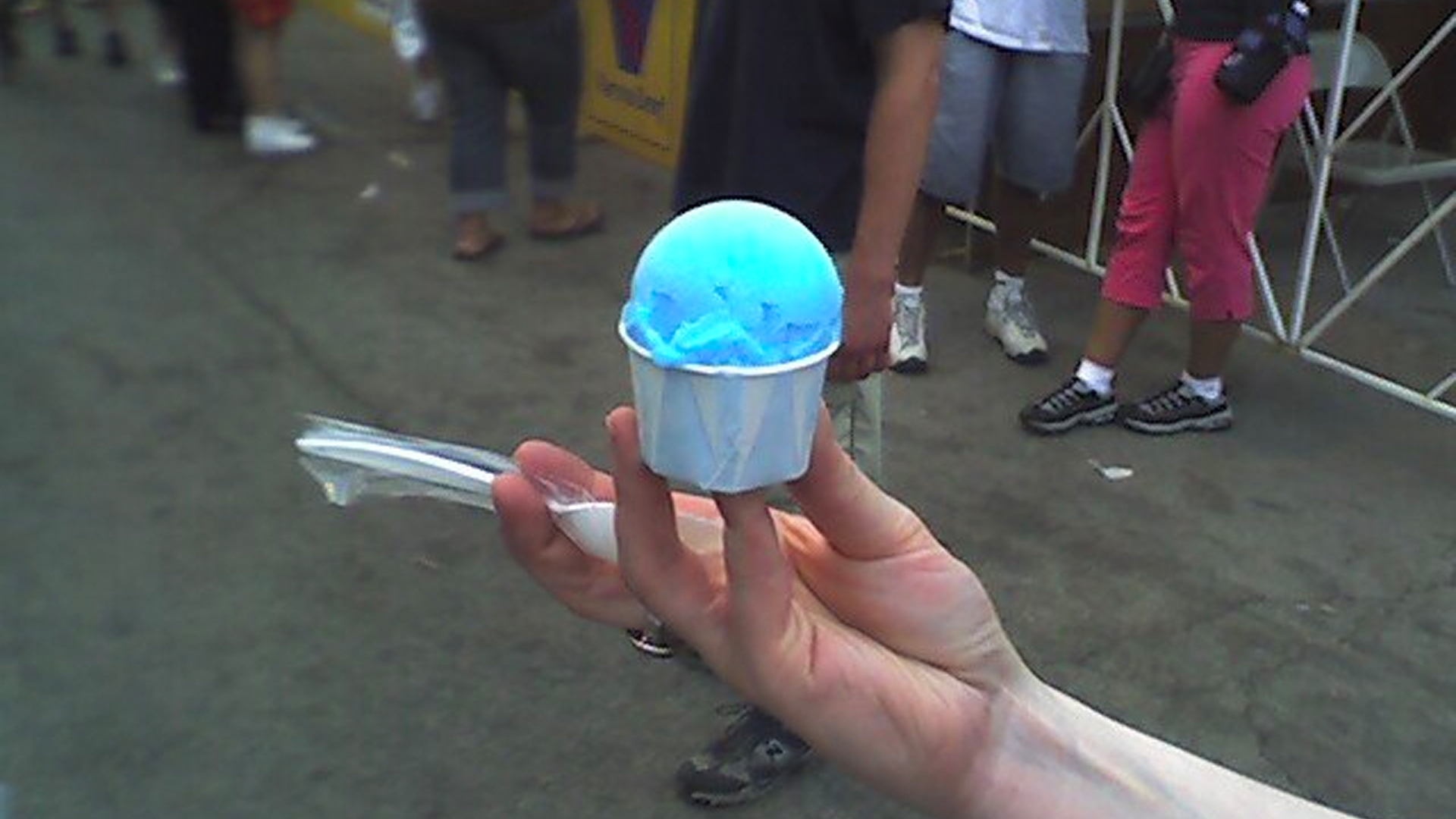Italian Ice has long been a summer staple in Italian American enclaves. The frozen treat, also known as water ice in some places, has origins as far back as ancient Rome where alpine snow was combined with fruit and honey. At the start of the 20th century, artificial refrigeration and ice-making technology met up with Italian immigrants who, inspired by traditions of granita and sorbetto in southern Italy, invented a new type of frozen treat they called Italian Ice.
Sorbetto, Granita, Italian Ice

(Photo Credit: Freepik)
Antonio Latini, the 17th-century steward known for writing a seminal cookbook, includes an early recipe for sorbetto, a mixture of ice and fruit juice. Fruits like lemons and berries were popular flavors, although in some instances wine was also used.
Before artificial refrigeration, Italians relied on ice and snow collected in the alps to make frozen drinks, and since alpine snow was plentiful, even by the 19th century, most Neapolitans would have eaten it.
Neapolitan sorbetto is different from Sicilian Granita. Although Granita is made from fruit juice, sugar, and water much like sorbetto, during the freezing process, it is scraped to disrupt the crystal formation. The desired texture varies from city to city with places like Palermo preferring a grainy ice structure rather than a smoother structure.
Both granita and sorbetto are different from gelato in that the gelato contains skim milk (and in turn, ice cream contains cream).
American-style Italian Ice, sometimes known as water ice, achieves a smooth and creamy texture but doesn't contain dairy.
Italian Ice Spreads To Europe

"Italian Ice" can also be linked to the French Renaissance thanks to Sicilian-born Francesco Procopio dei Coltelli. He operated Café Procope, the famed literary salon and cafe in Paris in the 1680s where it is said he first introduced Italian ices to the French.
Procope's frozen treats likely resembled Sicilian Granita rather than the American Italian ice, despite their similar name. One major evolution of the cafe's recipe was replacing honey with refined sugar, increasingly available in France thanks to colonial plantations in the Americas.
Italian Immigrants Popularize Cold Treats

The United States had developed a rather unique relationship with ice by the 19th century. Artificially chilled ice and ice harvested from lakes during winter had grown into big business. Innovations in ice harvesting and manufacturing created whole new industries like refrigeration to preserve food and ice cream, a popular American treat.
As the Italian diaspora accelerated, the American ice industry was in full swing. Italian immigrants arriving in the United States were instrumental in building the frozen dessert consumer market. First, many of the Sicilian immigrants already knew of Granita, sorbetto, and even gelato. These were popular in southern Italy, making Italian immigrants ideal salespeople for frozen products.
"Italian immigrants, along with black entrepreneurs, were largely responsible for popularizing ice cream with the masses," explained Dr. Amy Brady, author of Ice: From Mixed Drinks to Skating Rinks--a Cool History of a Hot Commodity, "These Italian Americans would either wear packs or push carts full of ice and had cartons of freshly made ice cream in them that they would sell to kids, kind of like an ice cream truck today. They would ring the bell and say 'ice cream, ice cream' and the kids would come."
She also notes these early ice peddlers often weren't the most sanitary ways of selling frozen treats. "An interesting and gross side note is they would serve it in these little, thimble-size glasses that they would then take back and kind of dip in the melt water to rinse out and refill the same cup for the next customer. A lot of people got sick."
Despite the spread of communicable diseases, America's taste for ice cream, sorbet, and Italian Ice grew rapidly.
New York's Italian Ice Tradition

What started out as pushcarts selling ice cream eventually became trucks, like the one operated by Ralph Silverstro on Staten Island. He sold Italian ice from his truck as early as 1928. Eventually, his business grew enough that could open a brick-and-mortar store, Ralphs, on Port Richmond Avenue in 1949.
A similar story was transpiring in Corona, Queens, where Nicola Benfaremo started selling Italian ice flavored with lemon and pineapple out of his garage back in 1944. His son Peter, who eventually became known as The Lemon Ice King Of Corona, opened a shop in 1964, a few blocks from the World's Fair. The Lemon Ice King was competing that year with a Greek immigrant, Marinos Vourderis, who opened an Italian Ice shop inside the World's Fair. His company Mariano's Italian Ice would go on to become an icon of ice cream trucks and grocery stores.
And meanwhile, in Brooklyn, Gino Broncanelli was selling Italian ice from an empty lot near his house. Gino's would also become an icon, finding its way into pizzerias across the city. Gino's also operated until recently a retail shop in Brooklyn. The wholesale arm of Gino's became synonymous with the city's pizzerias and Italian Ice became a seasonal staple. The plant processed orders from spring to fall.
Next door in New Jersey, smaller Italian ice manufacturers developed in similar ways, particularly in Italian enclaves like Elizabeth, originally home to shops like Little Jimmy's and Di Cosimo's.
By the 1970s, Italian ice spread across the United States, heading westward beyond even Italian American communities. Small regional chains operated in places like California, but supermarkets also carried Italian Ice in the freezer section, with brands like Centrone's. Part of the appeal of Italian Ice was the promise of a "low fat" frozen treat. Made without ice cream, it appealed to the diet conscious.
Today, one of the bigger Italian Ice chains in New York is Uncle Louie G's, founded in 1999. The chain has 45 franchises in seven states. That might sound like a lot but remains small compared to Rita's Ice, a Philadelphia “water ice" brand with more than 550 locations, including some recently opened in New York City.
Philadelphia Water Ice

In Central New Jersey there is the Italian Ice vs. Water Ice divide that matches with the Italian hero vs. Italian hoagie divide. North of that line, Italian Ice is known as Italian Ice. But pass to the south, and suddenly Italian ice becomes water ice – better known by locals as the phonetic "wuh-duh ice."
At the turn of the 20th century, "water ice" recipes were popular drinks made at home using block ice. The Philadelphia Inquirer in 1906 featured a spread of recipes including water ice and sherbets. The article depicts a cup for "Roman punch or sherbert" alongside water ice recipes that include raspberry and red currant. This tradition might be why Philadelphians refer to Italian ice as water ice.
One of the earliest industrial manufacturers–perhaps the first in the country– was Rosati's based in Clifton Heights, just outside of Philadelphia. Like many Italian immigrants, Michael Rosati began selling Italian ice from a pushcart, first in Naples, and then the United States. His son, Samuel Rosati, told the Delaware County Daily Times back in 1968 that he first started learning the ice business as a six-year-old working for his father. The family would all work to process the fruit for the ice each night.
Michael Rosati sold water ice with orange and lemon flavors and put his whole family to work making the product. But he was fascinated with ice manufacturing, then a nascent technology. The Rosati's opened an ice factory in Philadelphia in 1912 to produce ice using a steam engine, and then gasoline. Equipped with a horse cart, the Rosati company sold ice in the city and as far away as the Jersey shore, then just starting to become a summer attraction.
Sam Rosati took over the water ice business when his father passed away in 1943, separating the water ice from the block ice. He expanded the dessert business on a wholesale level rather than focusing on retail sales. Rosati became a major wholesaler adding lines of water ice that eventually went to school lunches, and expanding the recipes to include tropical flavors.
In addition to larger industrial Italian ice, Philadelphia's water ice also has traditional small-scale shops like Pop's, which started in the 1930s as a pushcart; John's Water Ice, opened in 1945, has just four flavors; Italiano's, opened in 1974 by the son of Pop; and Fred's founded more recently in 1988.
However, perhaps the best-known water ice retailer is Rita's Ice, a mega-chain sprawled across 30 states with more than 550 shops. Bob Tumolo, a firefighter, launched the company in 1984 naming it after his wife.
Rita's has dozens of flavors of Italian Ice, but also offers dairy-based custard and gelato. Many of the franchise shops operate seasonally, and on the first day of spring each year, customers are treated to a free ice. The franchise empire has even brought wud-dah ice to New York City, although Rita's website now refers to the product as Italian ice.
Chicago's Italian Lemonade

Mario DiPaolo, Jr., better known as "Skip," was a difficult-to-control child. His father, Mario Sr., bought his son an ice cream churn with the hope of channeling the chaotic energy into something productive. Skip began churning frozen lemonade.
In 1954, Mario Sr. expanded the hobby into a business building a storefront to sell Italian Lemonade. The family-run stand has been operating for 69 years selling Italian Lemonade, as they call it, although there are now other flavors available at the seasonal stand.
Chicago has a few other places to find Italian ice, like Carm's, offering 11 flavors and operating since 1929. This neighborhood establishment also serves up classic Italian beef. Miko's Italian Ice is a stand with up to 25 flavors, although they usually rotate. The first stand opened in 1997, but has since closed with two other locations in the city.
Lezzi Spumoni & Desserts also sells Italian ice, although the shop is better known for its Spumoni ice cream. Traditional Neapolitan spumoni is made from three flavors of gelato – typically, strawberry, pistachio, and chocolate–and includes chunks of fruit and nuts. The ice cream is usually molded into a block. Spumoni is also a common flavor of Italian ice where a rainbow of the three colors is combined. Salvatore Lezza arrived in Chicago in 1905 and began selling his distinctive rum, chocolate, strawberry, and pistachio spumoni. Lezza's offers traditional granita as well as Italian Ice.
Across The Nation

Today, Italian ice is widely available in the United States. The treat spread rapidly in the 1960s and 1970s as diet-conscious consumers fell in love with a sweet, dairy-free frozen treat. Regional chains offer local varieties in hundreds of flavors. Whether it's Italian Ice, Italian Lemonade, or Water Ice, this frozen dessert is a great way to cool off on a hot day.
Ian MacAllen
Ian MacAllen is America Domani's Senior Correspondent and the author of Red Sauce: How Italian Food Became American. He is a writer, editor, and graphic designer living in Brooklyn. Connect with him at IanMacAllen.com or on Twitter @IanMacAllen.


